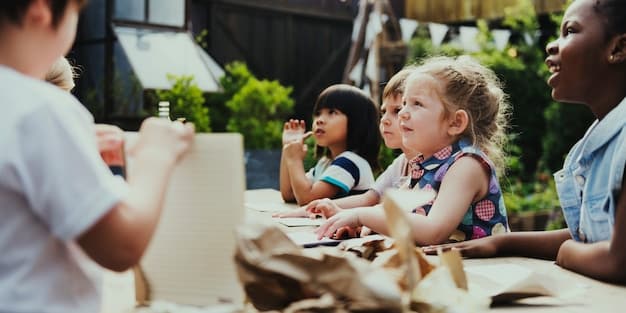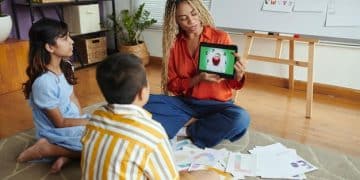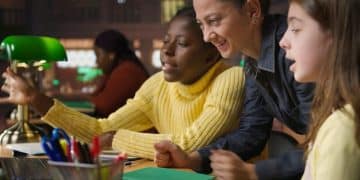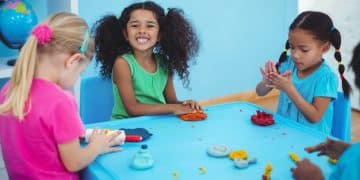Exploring Alternative Education: Montessori, Waldorf, Unschooling

Anúncios
Exploring alternative education models like Montessori, Waldorf, and Unschooling offers diverse pedagogical approaches beyond traditional schooling, each emphasizing distinct philosophies for fostering holistic child development, self-directed learning, and individualized educational paths.
Anúncios
The landscape of education is vastly more diverse than the conventional classroom often portrays. For parents and educators seeking different paths, Exploring Alternative Education Models: Montessori, Waldorf, and Unschooling presents intriguing frameworks. These approaches, fundamentally distinct yet united by a child-centric philosophy, challenge traditional paradigms and offer rich environments for growth.
The Enduring Appeal of Alternative Education
Alternative education refers to a spectrum of pedagogical approaches that diverge significantly from mainstream, conventional schooling. These models typically emphasize individualized learning, holistic development, and a deeper connection to real-world experiences. The enduring appeal stems from a desire for more personalized, engaging, and less restrictive learning environments than those often found in large, standardized school systems.
Anúncios
Parents often seek alternative education when their children do not thrive in traditional settings, or when they align with philosophies that prioritize innate curiosity and self-directed exploration over rote memorization and rigid curricula. The shift towards recognizing diverse learning styles has also fueled interest, as these models often cater to a broader range of intellectual and emotional needs, fostering a love for learning rather than a fear of failure.
Historical Roots and Evolution
The concepts underpinning many alternative educational models are not new; they have deep historical roots. Pioneers in education, often critical of the industrial model of schooling, sought to create environments that respected the child’s natural developmental stages and inherent drive to learn. Their work laid the groundwork for the approaches we see thriving today, demonstrating a persistent human need for educational systems that genuinely serve the individual.
Over time, these movements have evolved, adapting to contemporary understanding of child psychology and societal changes while retaining their core principles. The modern alternative education landscape is a testament to this evolution, offering diverse options that continue to innovate while holding fast to their foundational philosophies.
- Individualized Pace: Learning is adjusted to each child’s readiness, not a fixed schedule.
- Holistic Development: Focus extends beyond academics to include social, emotional, and physical well-being.
- Experiential Learning: Emphasis on hands-on activities and real-world application of knowledge.
- Autonomy and Choice: Children are given significant agency in their learning journey.
Ultimately, the appeal of alternative education lies in its promise to cultivate well-rounded, self-motivated individuals equipped not just with knowledge, but with critical thinking skills, resilience, and a lifelong passion for discovery. It represents a proactive decision to prioritize a child’s unique journey over adherence to a single, broad-stroke educational path.
Montessori: Cultivating Self-Directed Learners
The Montessori method, developed by Dr. Maria Montessori in the early 20th century, is perhaps one of the most recognized alternative education models. Its core tenet revolves around the belief that children possess an innate curiosity and capacity for self-education. The Montessori classroom is meticulously designed to support this natural inclination, featuring a carefully prepared environment with specific, self-correcting materials that encourage hands-on, self-directed learning.
In a Montessori setting, children are typically grouped in multi-age classrooms, fostering a sense of community and allowing younger children to learn from older peers, while older ones reinforce their understanding by teaching. The role of the teacher, or “directress,” is not to lecture but to observe, guide, and facilitate, introducing materials when a child is ready and stepping back to allow independent exploration. This emphasis on freedom within limits encourages responsible choice-making and intrinsic motivation.
Key Principles of Montessori Education
Montessori education is built upon several foundational principles that distinguish it from traditional systems. These principles guide everything from classroom layout to pedagogical practices, ensuring a cohesive and effective learning experience designed to nurture the whole child.
- Prepared Environment: The classroom is neatly organized with didactic materials that invite exploration and learning.
- Mixed-Age Classrooms: Promotes natural mentorship and peer-to-peer learning.
- Child-Centered Learning: Education driven by the child’s interests and developmental stage.
- Sensitive Periods: Recognition of specific windows when a child is most receptive to learning particular skills.
The focus on practical life skills, sensorial education, language, mathematics, and culture ensures a comprehensive curriculum. Children learn to care for themselves and their environment, developing coordination, concentration, independence, and a deeper understanding of the world around them. The self-correcting nature of the materials means children discover their own errors, fostering problem-solving skills and resilience without external judgment.
Montessori education aims to develop not just academic proficiency, but also strong character traits such as independence, discipline, concentration, and a respect for others and the environment. It nurtures a child’s natural intellectual curiosity, leading to a profound and lasting love of learning that extends far beyond the classroom walls.
Waldorf: Nurturing the Whole Child Through Arts and Imagination
The Waldorf education system, founded by Rudolf Steiner, offers a distinctly different approach from Montessori, focusing heavily on integrating academic, artistic, and practical activities. It views the child as a developing being with distinct stages of consciousness, and its curriculum is designed to meet these developmental phases in a holistic manner. Waldorf schools emphasize imagination, creativity, and the development of inner resources, rather than solely focusing on intellectual achievement.
In Waldorf education, academics are often introduced through storytelling, song, movement, and a rich array of artistic experiences. Early childhood education is centered around play, imitation, and sensory experiences, with formal academics typically starting later than in conventional schools. The curriculum unfolds in a spiral, re-visiting subjects at different ages with increasing depth and complexity, allowing concepts to ripen within the child.
Curriculum and Learning Environment
The Waldorf curriculum is renowned for its breadth and depth, encompassing traditional subjects alongside handcrafts, music, eurythmy (a form of movement art), gardening, and practical skills. Learning is often thematic, with “main lesson blocks” focusing on one subject for several weeks, fostering deep immersion rather than fragmented lessons. The teacher typically stays with the same class for multiple years, building strong relationships and understanding individual student needs deeply.

The learning environment in Waldorf schools is intentionally warm, aesthetically pleasing, and free from excessive digital technology, especially in the younger grades. Natural materials and a home-like atmosphere are preferred, designed to foster a sense of beauty, wonder, and security. Assessment is typically holistic, based on observation and qualitative understanding of a child’s progress, rather than standardized tests.
- Developmental Stages: Curriculum aligns with specific phases of child development.
- Artistic Integration: Learning is permeated by music, art, and movement.
- Teacher Continuity: A single main teacher often stays with the class for many years.
- Emphasis on Play: Free imaginative play is crucial, especially in early years.
Waldorf education seeks to foster free-thinking, morally responsible, and capable individuals who are deeply connected to themselves, others, and the natural world. It prioritizes the nurturing of imagination, empathy, and practical capacities, believing these are essential for a fulfilling human life and effective participation in society.
Unschooling: The Ultimate in Learner Autonomy
Unschooling stands out as the most radical departure from conventional education, even among alternative models. Unlike Montessori or Waldorf, which are structured educational philosophies, unschooling is less about a method and more about an approach to life and learning. At its heart, unschooling advocates for learning that is driven entirely by the child’s natural curiosity and interests, without a prescribed curriculum, mandatory lessons, or formal assessments.
It operates on the profound trust that children are inherently curious and will seek out knowledge and skills when they are ready and motivated. Parents in an unschooling environment act as facilitators, providing resources, answering questions, and creating a supportive, stimulating home environment. Learning happens organically through everyday experiences, play, exploration, conversations, and the pursuit of passions.
Principles and Practice of Unschooling
The practice of unschooling varies widely among families, reflecting the individualized nature of the approach. There’s no one-size-fits-all model; instead, each family creates a learning ecosystem that best suits their children. A child interested in dinosaurs might spend weeks researching, visiting museums, drawing, and reading books, while another might delve into coding, music, or cooking.
Critics often raise concerns about “gaps” in knowledge or socialization. However, unschooling advocates argue that a child driven by intrinsic motivation learns more deeply and retains information more effectively. Socialization happens naturally through community involvement, friendships, and family interactions, often providing more diverse social experiences than limited peer groups in traditional schools.
- Interest-Led Learning: Education is driven solely by the child’s chosen pursuits.
- No Fixed Curriculum: There are no set subjects or learning timelines.
- Parent as Facilitator: Role is to support and provide resources, not to direct.
- Learning is Life: Education happens continuously through daily living and exploration.
Unschooling requires a significant shift in mindset for parents, demanding trust in the child’s inherent capabilities and a willingness to step away from traditional educational expectations. It is a philosophy that views learning as an inseparable part of living, where every experience holds the potential for growth and discovery, fostering individuals who are deeply self-aware, motivated, and adaptable lifelong learners.
Comparing the Models: Philosophy, Structure, and Outcomes
While Montessori, Waldorf, and Unschooling all fall under the umbrella of alternative education, they represent distinct philosophies and offer very different learning experiences. Understanding their core distinctions is crucial for anyone considering which path might be best for a child.
Montessori is characterized by its structured environment and specific didactic materials, emphasizing self-correction and practical life skills. It promotes independent learning within a prepared setting, leading to children who are often highly self-disciplined and focused. Waldorf, on the other hand, embraces artistic expression, imagination, and a developmental approach, often delaying formal academics and fostering creativity, emotional intelligence, and a connection to the arts. Unschooling offers the least structure, focusing on child-led, interest-driven learning that integrates completely with daily life, cultivating extreme autonomy and intrinsic motivation.
Key Differences in Pedagogical Approach
The role of the teacher also varies significantly across these models. In Montessori, the teacher is a “directress” or guide, introducing materials and observing. In Waldorf, the teacher is often a central figure who stays with the class for many years, nurturing the children’s imaginative and emotional development. In unschooling, parents are facilitators, providing support and resources without imposing a curriculum.
Outcomes, while hard to quantify broadly, also tend to differ. Montessori often produces children who are highly organized, capable of independent work, and adept at problem-solving. Waldorf graduates are often noted for their creativity, artistic abilities, and holistic view of the world. Unschoolers frequently demonstrate strong self-motivation, adaptability, and an ability to pursue their passions with singular focus, though their path to conventional academic achievement may look different.

The choice between these models often comes down to alignment with a family’s values, a child’s personality, and the desired learning outcomes. There is no single “best” model, as each offers unique strengths and challenges. The key is to find an environment that resonates with the child’s individual needs and fosters their unique potential in a supportive and stimulating manner.
Challenges and Considerations for Families
While the allure of alternative education models is strong, families considering Montessori, Waldorf, or Unschooling must also weigh significant challenges and practical considerations. These paths often require a greater degree of parental involvement, financial commitment, and a willingness to deviate from societal norms regarding schooling.
For Montessori and Waldorf, tuition fees can be substantially higher than public school options, and the availability of schools can be limited, particularly in rural areas. The philosophies themselves might also require a shift in parenting style to align with the school’s approach, creating a consistent environment between home and school. Parents might need to educate themselves extensively on the pedagogical principles to fully support their child’s learning journey.
Navigating Social and Academic Reintegration
Unschooling, in particular, presents unique challenges. It demands a profound trust in the child and a significant commitment from parents to facilitate learning opportunities. Concerns about “socialization” are common, though unschooling families typically find abundant social interaction through community groups, sports, and shared interests. Another frequent question revolves around academic structure and future prospects, particularly regarding college admissions. However, many unschooled individuals successfully navigate higher education and diverse career paths, often demonstrating exceptional self-reliance and initiative.
- Financial Investment: Many alternative schools are private and have significant tuition.
- Availability: Specialized schools may not be accessible in all locations.
- Parental Commitment: Requires active engagement and understanding of the philosophy.
- Societal Perceptions: Deviating from norms can lead to questions from extended family and friends.
Ultimately, choosing an alternative education model is a deeply personal decision. It requires thorough research, self-reflection, and often, a leap of faith. Families must consider not only the potential benefits but also the practicalities, ensuring they can provide the consistent support and resources necessary for their child to thrive in these distinct and often demanding educational environments.
The Future of Learning: Embracing Diversity in Education
The increasing interest in alternative education models like Montessori, Waldorf, and Unschooling points to a broader trend: a growing recognition that one-size-fits-all education may no longer serve the diverse needs of modern learners. As the world becomes more complex and interconnected, the skills required for success—creativity, critical thinking, adaptability, and intrinsic motivation—are precisely what these alternative models often prioritize.
The future of learning seems poised to embrace greater diversity and flexibility. Traditional systems are even beginning to incorporate elements from these alternative philosophies, such as project-based learning, multi-age classrooms, and a focus on socio-emotional development. This cross-pollination benefits all students, fostering more engaging and effective learning environments.
Innovation and Adaptability
Technological advancements also play a role, making resources more accessible for unschooling families and allowing for blended learning approaches that combine elements of home-based and formal education. The experience of the past few years, particularly with remote learning, has further highlighted the need for adaptable and resilient educational frameworks that can continue to serve students under varied circumstances.
Ultimately, the journey into alternative education is about empowering children to become active participants in their own learning. It cultivates a genuine love for inquiry and discovery, preparing them not just for specific tests or careers, but for a lifetime of learning and adaptation in an ever-changing world. Embracing this diversity in educational approaches is not merely a choice for some families; it may well be a blueprint for the future of effective and meaningful learning for all children.
| Key Aspect | Brief Description |
|---|---|
| 🌱 Montessori: Self-Directed | Child-led learning in a prepared environment with specific didactic materials. |
| 🎨 Waldorf: Holistic & Artistic | Imagination-rich, arts-integrated curriculum aligned with developmental stages. |
| 📚 Unschooling: Interest-Led Living | Learning driven by child’s curiosity, integrated into daily life experiences. |
| 💡 Key Commonality | All models prioritize child-centric approaches and holistic development. |
Frequently Asked Questions About Alternative Education
Alternative education encompasses pedagogical approaches that differ from typical public or private schooling. These models focus on diverse learning styles, individualized paths, and holistic development, prioritizing autonomy and interest-driven exploration over standardized curricula. They aim to foster critical thinking, creativity, and a love for lifelong learning.
Montessori emphasizes self-directed learning in a structured environment with specific materials, promoting independence and concentration. Waldorf focuses more on holistic development through arts, imagination, and a curriculum aligned with developmental stages, often delaying formal academics. Both are child-centered but use distinct methods and philosophies.
Yes, many unschooled children successfully attend college. Universities increasingly recognize varied educational backgrounds. Unschoolers often present portfolios of their learning, demonstrate strong self-motivation, and craft compelling essays reflecting their unique experiences. Their ability to learn independently is often highly valued in academic settings.
Montessori and Waldorf schools can achieve accreditation through their respective organizations, which ensures adherence to specific standards. Unschooling, as a philosophy, is not “accredited” but operates under homeschooling regulations, which vary by state. It’s crucial for families to research local laws and specific school accreditations.
Key benefits include fostering strong intrinsic motivation, developing critical thinking and problem-solving skills, promoting creativity, and nurturing emotional intelligence. These models often provide a less stressful environment for children who may not thrive in traditional schools, allowing for a more personalized and holistic developmental path.
Conclusion
Exploring alternative education models such as Montessori, Waldorf, and Unschooling reveals a rich tapestry of pedagogical approaches, each rooted in a profound respect for the child’s innate capacity to learn and grow. These pathways offer compelling alternatives to conventional schooling, prioritizing holistic development, fostering intrinsic motivation, and cultivating skills essential for a dynamic future. The choice among them is deeply personal, reflecting a family’s values and a child’s unique needs, yet all point towards a future where education is more adaptable, diverse, and profoundly human-centered.





